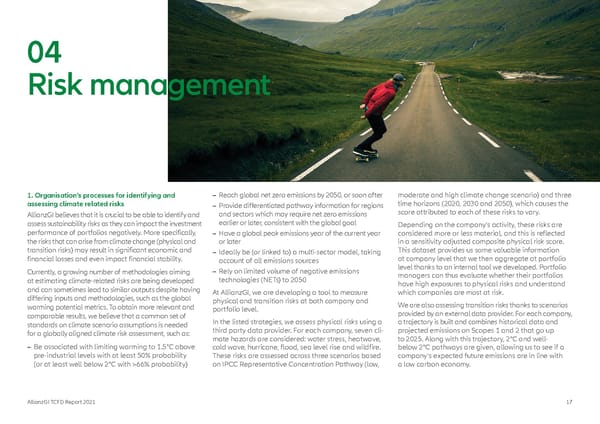04 Risk management 1. Organisation’s processes for identifying and – Reach global net zero emissions by 2050, or soon after moderate and high climate change scenario) and three assessing climate related risks – Provide differentiated pathway information for regions time horizons (2020, 2030 and 2050), which causes the AllianzGI believes that it is crucial to be able to identify and and sectors which may require net zero emissions score attributed to each of these risks to vary. assess sustainability risks as they can impact the investment earlier or later, consistent with the global goal Depending on the company’s activity, these risks are performance of portfolios negatively. More specifically, – Have a global peak emissions year of the current year considered more or less material, and this is reflected the risks that can arise from climate change (physical and or later in a sensitivity adjusted composite physical risk score. transition risks) may result in significant economic and – Ideally be (or linked to) a multi-sector model, taking This dataset provides us some valuable information financial losses and even impact financial stability. account of all emissions sources at company level that we then aggregate at portfolio Currently, a growing number of methodologies aiming – Rely on limited volume of negative emissions level thanks to an internal tool we developed. Portfolio at estimating climate-related risks are being developed technologies (NETs) to 2050 managers can thus evaluate whether their portfolios and can sometimes lead to similar outputs despite having have high exposures to physical risks and understand differing inputs and methodologies, such as the global At AllianzGI, we are developing a tool to measure which companies are most at risk. physical and transition risks at both company and We are also assessing transition risks thanks to scenarios warming potential metrics. To obtain more relevant and portfolio level. provided by an external data provider. For each company, comparable results, we believe that a common set of In the listed strategies, we assess physical risks using a a trajectory is built and combines historical data and standards on climate scenario assumptions is needed third party data provider. For each company, seven cli- projected emissions on Scopes 1 and 2 that go up for a globally aligned climate risk assessment, such as: mate hazards are considered: water stress, heatwave, to 2025. Along with this trajectory, 2°C and well- – Be associated with limiting warming to 1.5°C above cold wave, hurricane, flood, sea level rise and wildfire. below 2°C pathways are given, allowing us to see if a pre-industrial levels with at least 50% probability These risks are assessed across three scenarios based company’s expected future emissions are in line with (or at least well below 2°C with >66% probability) on IPCC Representative Concentration Pathway (low, a low carbon economy. AllianzGI TCFD Report 2021 17
 TCFD Report Page 16 Page 18
TCFD Report Page 16 Page 18